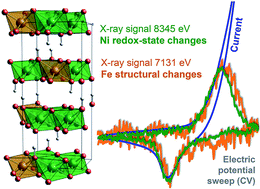Nickel-iron catalysts for electrochemical water oxidation – redox synergism investigated by in situ X-ray spectroscopy with millisecond time resolution†
Abstract
In future technological systems for chemical storage of renewable energy and production of non-fossil fuels, NiFe oxyhydroxides are prime candidates for efficient alkaline water oxidation (oxygen evolution reaction, OER). The synergistic effect of Ni and Fe is well documented but still insufficiently understood. Fluorescence-detected X-ray absorption spectroscopy at the K-edges of Ni and Fe provided structural information on the non-catalytic (reduced) and catalytic (oxidized) state of the NiFe catalyst. Time-resolved detection of X-ray signals during (i) cyclic voltammetry and (ii) in response to potential steps revealed that the Ni(2+)/Ni(3+) redox transition is directly coupled to modification of the Fe ligand environment. We propose that the lattice-geometry modification of the Ni(Fe) oxyhydroxide that results from Ni oxidation enforces changes in the ligand environment of the Fe ions. The Fe sites do not undergo a distinctive redox transition, but are “enslaved” by the oxidation state changes of the Ni ions.



 Please wait while we load your content...
Please wait while we load your content...